Attached files
| file | filename |
|---|---|
| 8-K - FORM 8-K - FEDERAL NATIONAL MORTGAGE ASSOCIATION FANNIE MAE | w77545e8vk.htm |
| EX-99.1 - EX-99.1 - FEDERAL NATIONAL MORTGAGE ASSOCIATION FANNIE MAE | w77545exv99w1.htm |
Exhibit 99.2
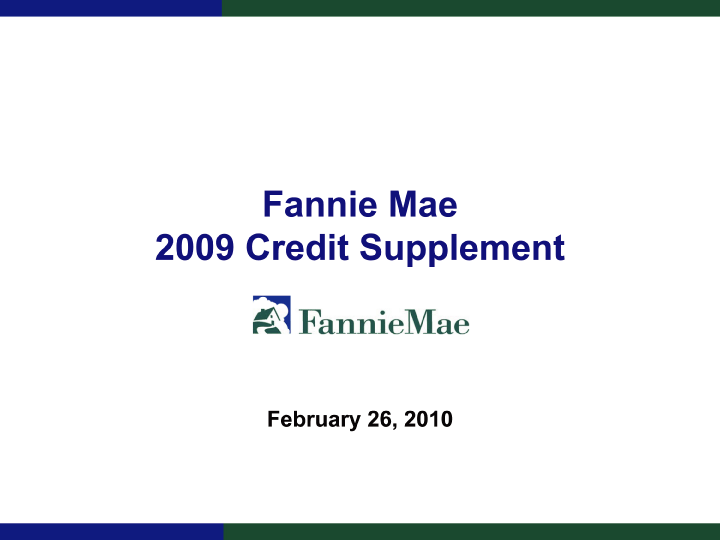
| Fannie Mae 2009 Credit Supplement February 26, 2010 |
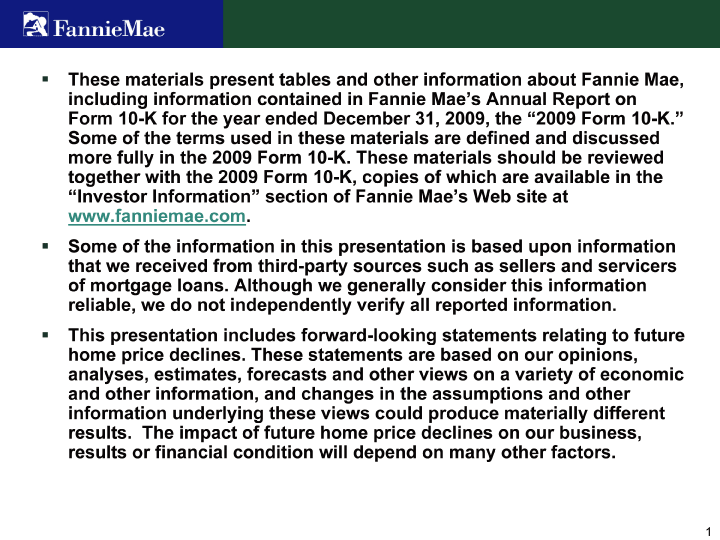
| These materials present tables and other information about Fannie Mae, including information contained in Fannie Mae’s Annual Report on Form 10-K for the year ended December 31, 2009, the “2009 Form 10-K.” Some of the terms used in these materials are defined and discussed more fully in the 2009 Form 10-K. These materials should be reviewed together with the 2009 Form 10-K, copies of which are available in the “Investor Information” section of Fannie Mae’s Web site at www.fanniemae.com. |
| Some of the information in this presentation is based upon information that we received from third-party sources such as sellers and servicers of mortgage loans. Although we generally consider this information reliable, we do not independently verify all reported information. This presentation includes forward-looking statements relating to future home price declines. These statements are based on our opinions, analyses, estimates, forecasts and other views on a variety of economic and other information, and changes in the assumptions and other |
| information underlying these views could produce materially different results. The impact of future home price declines on our business, results or financial condition will depend on many other factors. |
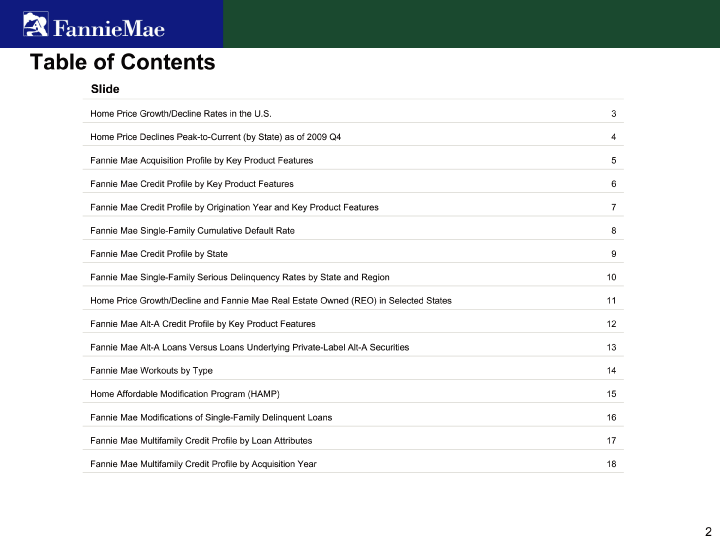
| Table of Contents |
| Slide |
| Home Price Growth/Decline Rates in the U.S. 3 |
| Home Price Declines Peak-to-Current (by State) as of 2009 Q4 4 |
| Fannie Mae Acquisition Profile by Key Product Features 5 |
| Fannie Mae Credit Profile by Key Product Features 6 |
| Fannie Mae Credit Profile by Origination Year and Key Product Features 7 |
| Fannie Mae Single-Family Cumulative Default Rate 8 |
| Fannie Mae Credit Profile by State 9 |
| Fannie Mae Single-Family Serious Delinquency Rates by State and Region 10 |
| Home Price Growth/Decline and Fannie Mae Real Estate Owned (REO) in Selected States 11 |
| Fannie Mae Alt-A Credit Profile by Key Product Features 12 |
| Fannie Mae Alt-A Loans Versus Loans Underlying Private-Label Alt-A Securities 13 |
| Fannie Mae Workouts by Type 14 |
| Home Affordable Modification Program (HAMP) 15 |
| Fannie Mae Modifications of Single-Family Delinquent Loans 16 |
| Fannie Mae Multifamily Credit Profile by Loan Attributes 17 |
| Fannie Mae Multifamily Credit Profile by Acquisition Year 18 |
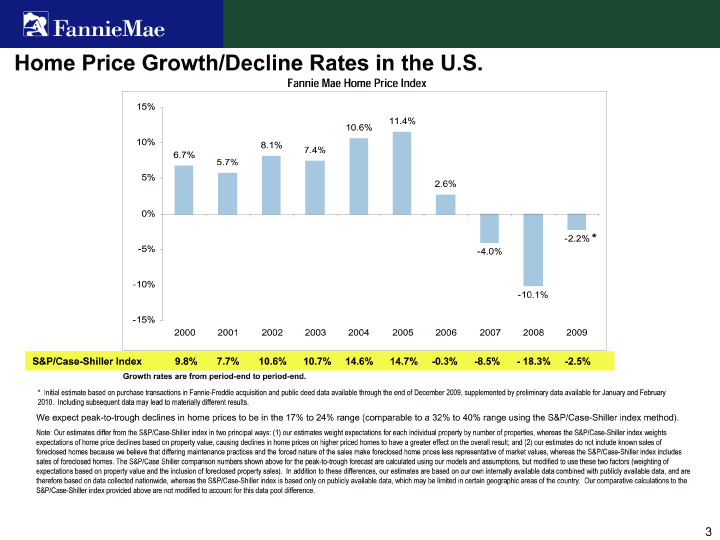
| Home Price Growth/Decline Rates in the U.S. |
| Fannie Mae Home Price Index |
| Growth rates are from period-end to period-end. * Initial estimate based on purchase transactions in Fannie-Freddie acquisition and public deed data available through the end of December 2009, supplemented by preliminary data available for January and February 2010. Including subsequent data may lead to materially different results. |
| We expect peak-to-trough declines in home prices to be in the 17% to 24% range (comparable to a 32% to 40% range using the S&P/Case-Shiller index method). |
| Note: Our estimates differ from the S&P/Case-Shiller index in two principal ways: (1) our estimates weight expectations for each individual property by number of properties, whereas the S&P/Case-Shiller index weights expectations of home price declines based on property value, causing declines in home prices on higher priced homes to have a greater effect on the overall result; and (2) our estimates do not include known sales of foreclosed homes because we believe that differing maintenance practices and the forced nature of the sales make foreclosed home prices less representative of market values, whereas the S&P/Case-Shiller index includes sales of foreclosed homes. The S&P/Case Shiller comparison numbers shown above for the peak-to-trough forecast are calculated using our models and assumptions, but modified to use these two factors (weighting of expectations based on property value and the inclusion of foreclosed property sales). In addition to these differences, our estimates are based on our own internally available data combined with publicly available data, and are therefore based on data collected nationwide, whereas the S&P/Case-Shiller index is based only on publicly available data, which may be limited in certain geographic areas of the country. Our comparative calculations to the S&P/Case-Shiller index provided above are not modified to account for this data pool difference. |
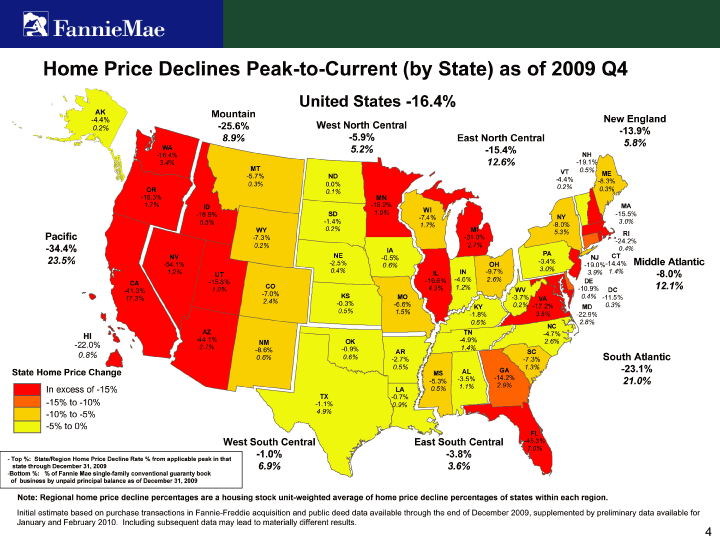
| Home Price Declines Peak-to-Current (by State) as of 2009 Q4 |
| - Top %: State/Region Home Price Decline Rate % from applicable peak in that state through December 31, 2009 -Bottom %: % of Fannie Mae single-family conventional guaranty book of business by unpaid principal balance as of December 31, 2009 |
| Note: Regional home price decline percentages are a housing stock unit-weighted average of home |
| price decline percentages of states within each region. |
| Initial estimate based on purchase transactions in Fannie-Freddie acquisition and public deed data available through the end of December 2009, supplemented by preliminary data available for January and February 2010. Including subsequent data may lead to materially different results. |
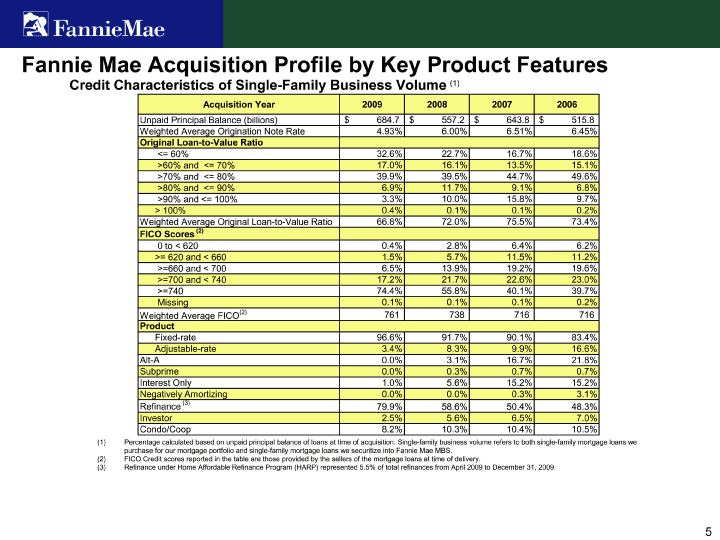
| Fannie Mae Acquisition Profile by Key Product Features |
| Credit Characteristics of Single-Family Business Volume (1) |
| Fannie Mae Acquisition Profile by Key Product Features |
| Credit Characteristics of Single-Family Business Volume (1) |
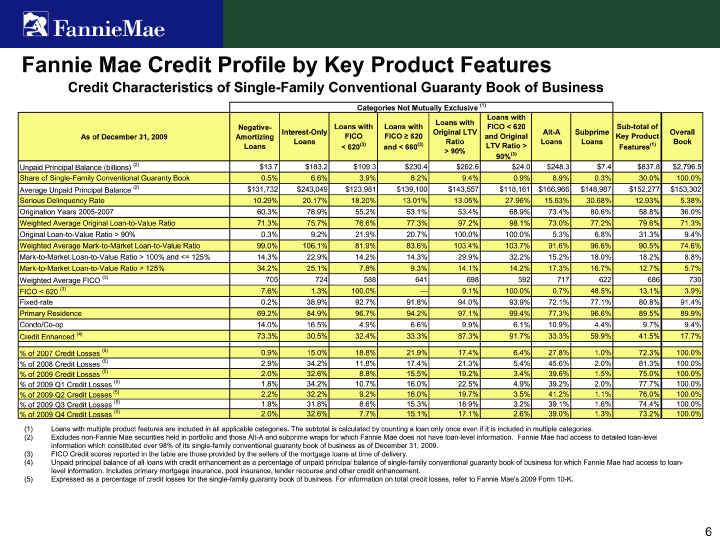
| Fannie Mae Credit Profile by Key Product Features |
| Credit Characteristics of Single-Family Conventional Guaranty Book of Business |
| (1) Loans with multiple product features are included in all applicable categories. The subtotal is calculated by counting a loan only once even if it is included in multiple categories. |
| (2) Excludes non-Fannie Mae securities held in portfolio and those Alt-A and subprime wraps for which Fannie Mae does not have loan-level information. Fannie Mae had access to detailed loan-level information which constituted over 98% of its single-family conventional guaranty book of business as of December 31, 2009. |
| (3) FICO Credit scores reported in the table are those provided by the sellers of the mortgage loans at time of delivery. |
| (4) Unpaid principal balance of all loans with credit enhancement as a percentage of unpaid principal balance of single-family conventional guaranty book of business for which Fannie Mae had access to loan- level information. Includes primary mortgage insurance, pool insurance, lender recourse and other credit enhancement. |
| (5) Expressed as a percentage of credit losses for the single-family guaranty book of business. For information on total credit losses, refer to Fannie Mae’s 2009 Form 10-K. |
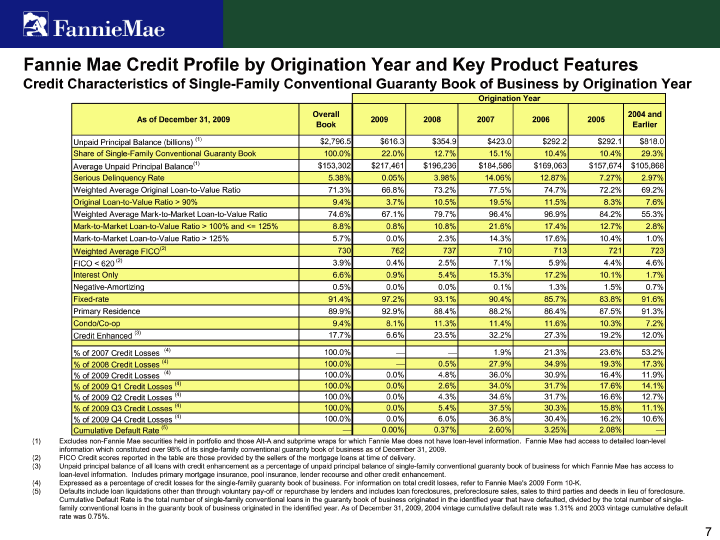
| Fannie Mae Credit Profile by Origination Year and Key Product Features |
| Credit Characteristics of Single-Family Conventional Guaranty Book of Business by Origination |
| Year |
| (1) Excludes non-Fannie Mae securities held in portfolio and those Alt-A and subprime wraps for which Fannie Mae does not have loan-level information. Fannie Mae had access to detailed loan-level information which constituted over 98% of its single-family conventional guaranty book of business as of December 31, 2009. |
| (2) FICO Credit scores reported in the table are those provided by the sellers of the mortgage loans at time of delivery. |
| (3) Unpaid principal balance of all loans with credit enhancement as a percentage of unpaid principal balance of single-family conventional guaranty book of business for which Fannie Mae has access to loan-level information. Includes primary mortgage insurance, pool insurance, lender recourse and other credit enhancement. |
| (4) Expressed as a percentage of credit losses for the single-family guaranty book of business. For information on total credit losses, refer to Fannie Mae’s 2009 Form 10-K. |
| (5) Defaults include loan liquidations other than through voluntary pay-off or repurchase by lenders and includes loan foreclosures, preforeclosure sales, sales to third parties and deeds in lieu of foreclosure. Cumulative Default Rate is the total number of single-family conventional loans in the guaranty book of business originated in the identified year that have defaulted, divided by the total number of single- family conventional loans in the guaranty book of business originated in the identified year. As of December 31, 2009, 2004 vintage cumulative default rate was 1.31% and 2003 vintage cumulative default rate was 0.75%. |
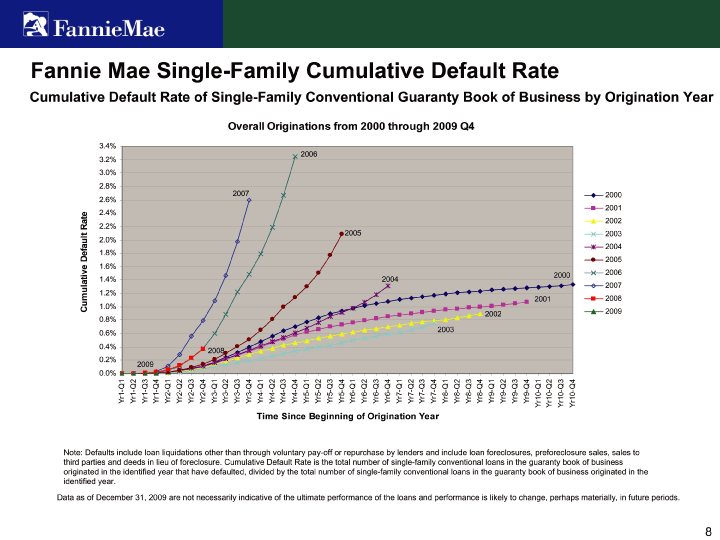
| Fannie Mae Single-Family Cumulative Default Rate |
| Cumulative Default Rate of Single-Family Conventional Guaranty Book of Business by Origination |
| Year |
| Overall Originations from 2000 through 2009 Q4 |
| Time Since Beginning of Origination Year |
| Note: Defaults include loan liquidations other than through voluntary pay-off or repurchase by lenders and include loan foreclosures, preforeclosure sales, sales to third parties and deeds in lieu of foreclosure. Cumulative Default Rate is the total number of single-family conventional loans in the guaranty book of business originated in the identified year that have defaulted, divided by the total number of single-family conventional loans in the guaranty book of business originated in the identified year. |
| Data as of December 31, 2009 are not necessarily indicative of the ultimate performance of the loans and performance is likely to change, perhaps materially, in future periods. |
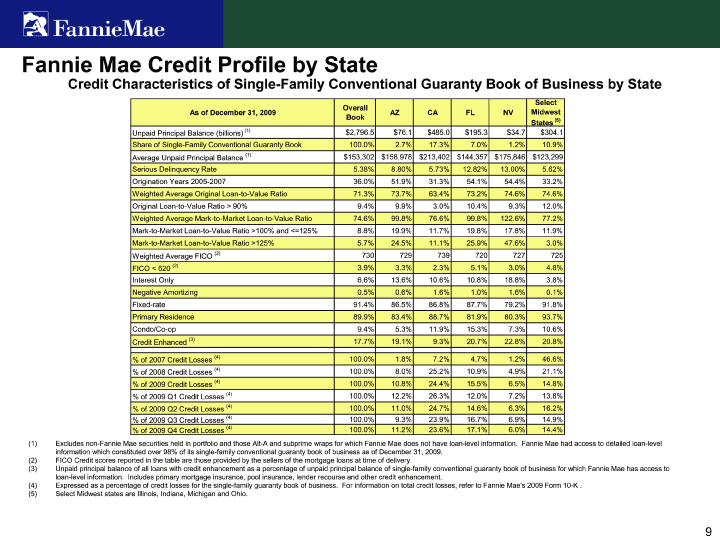
| Fannie Mae Credit Profile by State |
| Credit Characteristics of Single-Family Conventional Guaranty Book of Business by State |
| % of 2009 Q4 Credit Losses |
| (1) Excludes non-Fannie Mae securities held in portfolio and those Alt-A and subprime wraps for which Fannie Mae does not have loan-level information. Fannie Mae had access to detailed loan-level information which constituted over 98% of its single-family conventional guaranty book of business as of December 31, 2009. |
| (2) FICO Credit scores reported in the table are those provided by the sellers of the mortgage loans at time of delivery. |
| (3) Unpaid principal balance of all loans with credit enhancement as a percentage of unpaid principal balance of single-family conventional guaranty book of business for which Fannie Mae has access to loan-level information. Includes primary mortgage insurance, pool insurance, lender recourse and other credit enhancement. |
| (4) Expressed as a percentage of credit losses for the single-family guaranty book of business. For information on total credit losses, refer to Fannie Mae’s 2009 Form 10-K . (5) Select Midwest states are Illinois, Indiana, Michigan and Ohio. |
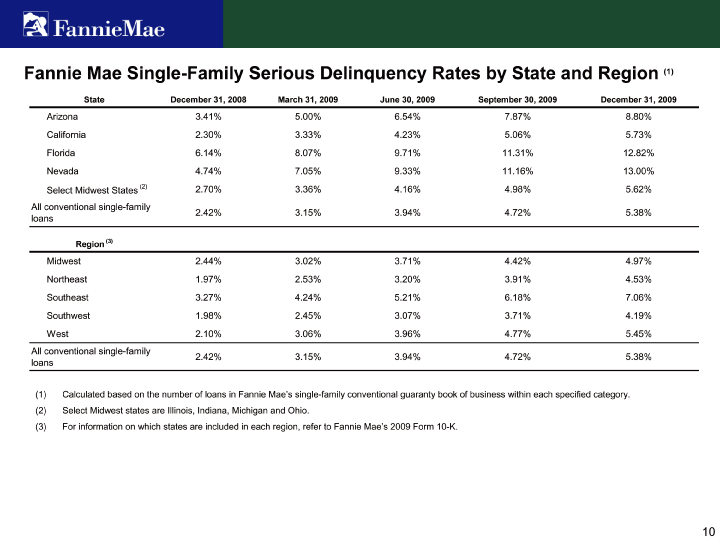
| Fannie Mae Single-Family Serious Delinquency Rates by State and Region (1) |
| Fannie Mae Single-Family Serious Delinquency Rates by State and Region (1) |
| Home Price Growth/Decline and Fannie Mae Real Estate Owned (REO) in Selected States |
| (1) Fannie Mae’s REO acquisitions and REO reflect the impact of Fannie Mae’s foreclosure moratoriums in late 2008 and early 2009 and its directive to loan servicers to delay foreclosure sales until the servicers have exhausted foreclosure prevention alternatives. |
| (2) Initial estimate based on purchase transactions in Fannie-Freddie acquisition and public deed data available through the end of December 2009, supplemented by preliminary data available for January and February 2010. Including subsequent data may lead to materially different results. |
| (3) Select Midwest states are Illinois, Indiana, Michigan and Ohio. |
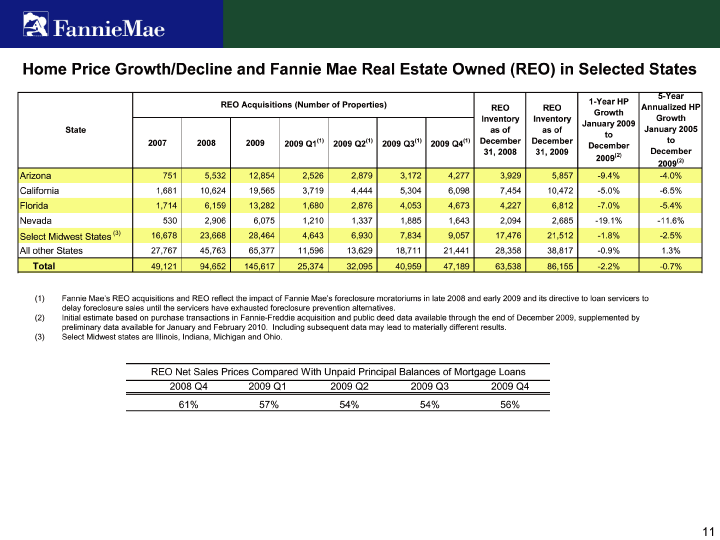
| REO Net Sales Prices Compared With Unpaid Principal Balances of Mortgage Loans |
| 2008 Q4 2009 Q1 2009 Q2 2009 Q3 2009 Q4 |
| 61% 57% 54% 54% 56% |
| Fannie Mae Alt-A Credit Profile by Key Product Features |
| Credit Characteristics of Alt-A Single-Family Conventional Guaranty Book of Business by |
| Origination Year |
| (1) 2004 and |
| As of December 31, 2009 Alt-A 2008 2007 2006 2005 |
| Earlier |
| Unpaid principal balance (billions) (2) $248.3 $6.3 $65.1 $70.1 $47.2 $59.7 |
| Share of Alt-A 100.0% 2.5% 26.2% 28.2% 19.0% 24.0% |
| Weighted Average Original Loan-to-Value Ratio 73.0% 67.3% 75.1% 74.2% 72.7% 70.1% |
| Original Loan-to-Value Ratio > 90% 5.3% 2.4% 8.7% 4.7% 3.2% 4.4% |
| Weighted Average Mark-to-Market Loan-to-Value Ratio 91.6% 77.3% 102.6% 105.3% 95.2% 62.1% |
| Mark-to-Market Loan-to-Value Ratio > 100% and <=125% 15.2% 10.6% 21.3% 18.0% 15.8% 5.0% |
| Mark-to-Market Loan-to-Value Ratio > 125% 17.3% 3.6% 21.5% 25.6% 19.1% 2.7% |
| Weighted Average FICO (3) 717 727 712 714 724 721 |
| FICO < 620 (3) 0.7% 0.2% 0.5% 0.5% 0.4% 1.4% |
| Adjustable-rate 27.9% 10.7% 22.8% 30.5% 40.0% 22.9% |
| Interest Only 29.8% 7.1% 38.5% 38.9% 29.7% 12.1% |
| Negative Amortizing 2.9% 0.0% 0.0% 4.0% 6.7% 2.0% |
| Investor 17.8% 18.5% 19.7% 17.2% 19.9% 14.6% |
| Condo/Co-op 10.9% 6.9% 10.0% 11.9% 13.2% 9.4% |
| California 22.0% 20.4% 22.4% 20.1% 20.9% 25.0% |
| Florida 11.5% 9.1% 12.2% 13.2% 12.8% 8.2% |
| Credit Enhanced (4) 33.3% 13.9% 32.1% 44.6% 36.1% 21.3% |
| 2008 Q4 Serious Delinquency Rate 7.03% 2.14% 9.61% 10.24% 6.64% 3.06% |
| 2009 Q1 Serious Delinquency Rate 9.54% 4.20% 13.51% 13.67% 8.86% 3.97% |
| 2009 Q2 Serious Delinquency Rate 11.91% 6.52% 17.05% 16.78% 10.97% 5.02% |
| 2009 Q3 Serious Delinquency Rate 13.97% 8.72% 20.19% 19.43% 12.72% 5.95% |
| 2009 Q4 Serious Delinquency Rate 15.63% 10.55% 22.72% 21.57% 14.24% 6.73% |
| % of 2007 Credit Losses (5) 27.8% # 0.7% 9.8% 9.7% 7.7% |
| % of 2008 Credit Losses (5) 45.6% 0.0% 12.4% 20.2% 9.7% 3.4% |
| % of 2009 Credit Losses (5) 39.6% 0.4% 13.4% 15.8% 7.3% 2.7% |
| % of 2009 Q1 Credit Losses (5) 39.2% 0.2% 12.2% 16.2% 7.7% 2.9% |
| % of 2009 Q2 Credit Losses (5) 41.2% 0.3% 13.5% 16.9% 7.7% 2.8% |
| % of 2009 Q3 Credit Losses (5) 39.1% 0.5% 13.7% 15.3% 7.2% 2.5% |
| % of 2009 Q4 Credit Losses (5) 39.0% 0.6% 13.7% 15.2% 7.0% 2.5% |
| Cumulative Default Rate (6) # 1.47% 5.84% 6.63% 4.39% # |
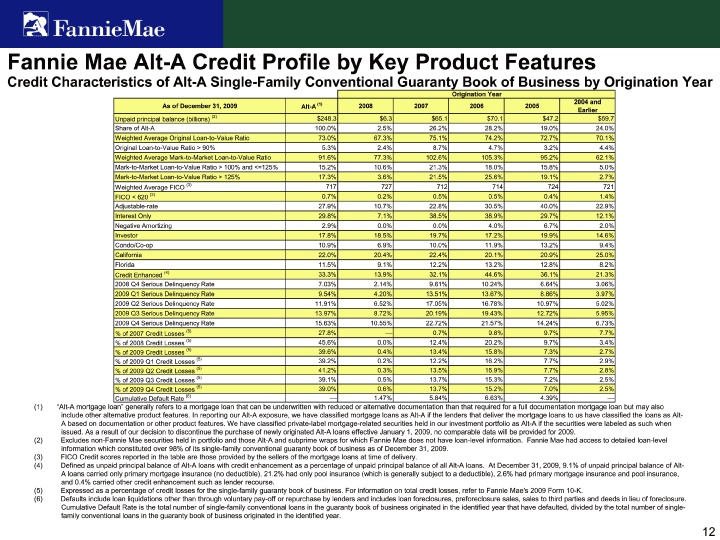
| (1) 2004 and |
| As of December 31, 2009 Alt-A 2008 2007 2006 2005 |
| Earlier |
| Unpaid principal balance (billions) (2) $248.3 $6.3 $65.1 $70.1 $47.2 $59.7 |
| Share of Alt-A 100.0% 2.5% 26.2% 28.2% 19.0% 24.0% |
| Weighted Average Original Loan-to-Value Ratio 73.0% 67.3% 75.1% 74.2% 72.7% 70.1% |
| Original Loan-to-Value Ratio > 90% 5.3% 2.4% 8.7% 4.7% 3.2% 4.4% |
| Weighted Average Mark-to-Market Loan-to-Value Ratio 91.6% 77.3% 102.6% 105.3% 95.2% 62.1% |
| Mark-to-Market Loan-to-Value Ratio > 100% and <=125% 15.2% 10.6% 21.3% 18.0% 15.8% 5.0% |
| Mark-to-Market Loan-to-Value Ratio > 125% 17.3% 3.6% 21.5% 25.6% 19.1% 2.7% |
| Weighted Average FICO (3) 717 727 712 714 724 721 |
| FICO < 620 (3) 0.7% 0.2% 0.5% 0.5% 0.4% 1.4% |
| Adjustable-rate 27.9% 10.7% 22.8% 30.5% 40.0% 22.9% |
| Interest Only 29.8% 7.1% 38.5% 38.9% 29.7% 12.1% |
| Negative Amortizing 2.9% 0.0% 0.0% 4.0% 6.7% 2.0% |
| Investor 17.8% 18.5% 19.7% 17.2% 19.9% 14.6% |
| Condo/Co-op 10.9% 6.9% 10.0% 11.9% 13.2% 9.4% |
| California 22.0% 20.4% 22.4% 20.1% 20.9% 25.0% |
| Florida 11.5% 9.1% 12.2% 13.2% 12.8% 8.2% |
| Credit Enhanced (4) 33.3% 13.9% 32.1% 44.6% 36.1% 21.3% |
| 2008 Q4 Serious Delinquency Rate 7.03% 2.14% 9.61% 10.24% 6.64% 3.06% |
| 2009 Q1 Serious Delinquency Rate 9.54% 4.20% 13.51% 13.67% 8.86% 3.97% |
| 2009 Q2 Serious Delinquency Rate 11.91% 6.52% 17.05% 16.78% 10.97% 5.02% |
| 2009 Q3 Serious Delinquency Rate 13.97% 8.72% 20.19% 19.43% 12.72% 5.95% |
| 2009 Q4 Serious Delinquency Rate 15.63% 10.55% 22.72% 21.57% 14.24% 6.73% |
| % of 2007 Credit Losses (5) 27.8% # 0.7% 9.8% 9.7% 7.7% |
| % of 2008 Credit Losses (5) 45.6% 0.0% 12.4% 20.2% 9.7% 3.4% |
| % of 2009 Credit Losses (5) 39.6% 0.4% 13.4% 15.8% 7.3% 2.7% |
| % of 2009 Q1 Credit Losses (5) 39.2% 0.2% 12.2% 16.2% 7.7% 2.9% |
| % of 2009 Q2 Credit Losses (5) 41.2% 0.3% 13.5% 16.9% 7.7% 2.8% |
| % of 2009 Q3 Credit Losses (5) 39.1% 0.5% 13.7% 15.3% 7.2% 2.5% |
| % of 2009 Q4 Credit Losses (5) 39.0% 0.6% 13.7% 15.2% 7.0% 2.5% |
| Cumulative Default Rate (6) # 1.47% 5.84% 6.63% 4.39% # |
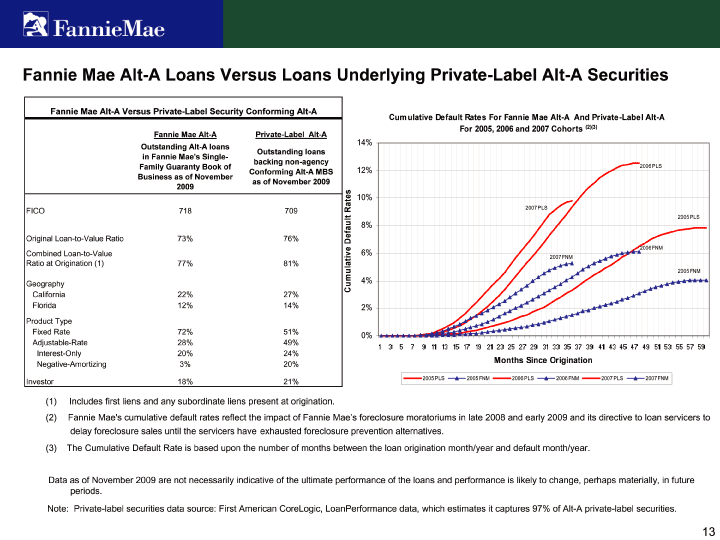
| Fannie Mae Alt-A Loans Versus Loans Underlying Private-Label Alt-A Securities |
| Fannie Mae Alt-A Versus Private-Label Security Conforming Alt-A |
| Fannie Mae Alt-A Private-Label Alt-A |
| Outstanding Alt-A loans |
| Outstanding loans |
| in Fannie Mae’s Single- |
| backing non-agency |
| Family Guaranty Book of |
| Conforming Alt-A MBS |
| Business as of November |
| as of November 2009 |
| 2009 |
| FICO 718 709 |
| Original Loan-to-Value 73% 76% Ratio |
| Combined Loan-to-Value |
| Ratio at Origination (1) 77% 81% |
| Geography |
| California 22% 27% |
| Florida 12% 14% |
| Product Type |
| Fixed Rate 72% 51% |
| Adjustable-Rate 28% 49% |
| Interest-Only 20% 24% |
| Negative-Amortizing 3% 20% |
| Investor 18% 21% |
| (1) Includes first liens and any subordinate liens present at origination. |
| (2) Fannie Mae’s cumulative default rates reflect the impact of Fannie Mae’s foreclosure moratoriums in late 2008 and early 2009 and its directive to loan servicers to delay foreclosure sales until the servicers have exhausted foreclosure prevention alternatives. |
| (3) The Cumulative Default Rate is based upon the number of months between the loan origination month/year and default month/year. |
| Data as of November 2009 are not necessarily indicative of the ultimate performance of the loans and performance is likely to change, perhaps materially, in future periods. |
| Note: Private-label securities data source: First American CoreLogic, LoanPerformance data, which estimates it captures 97% of Alt-A private-label securities. |
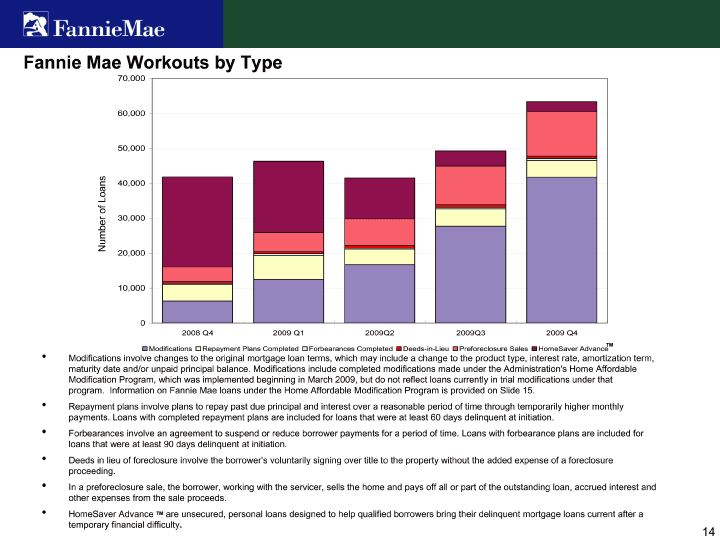
| Fannie Mae Workouts by Type |
| Modifications Repayment Plans Completed Forbearances Completed Deeds-in-Lieu Preforeclosure Sales HomeSaver AdvanceTM |
| • Modifications involve changes to the original mortgage loan terms, which may include a change to the product type, interest rate, amortization term, maturity date and/or unpaid principal balance. Modifications include completed modifications made under the Administration’s Home Affordable Modification Program, which was implemented beginning in March 2009, but do not reflect loans currently in trial modifications under that program. Information on Fannie Mae loans under the Home Affordable Modification Program is provided on Slide 15. |
| • Repayment plans involve plans to repay past due principal and interest over a reasonable period of time through temporarily higher monthly payments. Loans with completed repayment plans are included for loans that were at least 60 days delinquent at initiation. |
| • Forbearances involve an agreement to suspend or reduce borrower payments for a period of time. Loans with forbearance plans are included for loans that were at least 90 days delinquent at initiation. |
| • Deeds in lieu of foreclosure involve the borrower’s voluntarily signing over title to the property without the added expense of a foreclosure proceeding. |
| • In a preforeclosure sale, the borrower, working with the servicer, sells the home and pays off all or part of the outstanding loan, accrued interest and other expenses from the sale proceeds. |
| • HomeSaver Advance TM are unsecured, personal loans designed to help qualified borrowers bring their delinquent mortgage loans current after a temporary financial difficulty. |
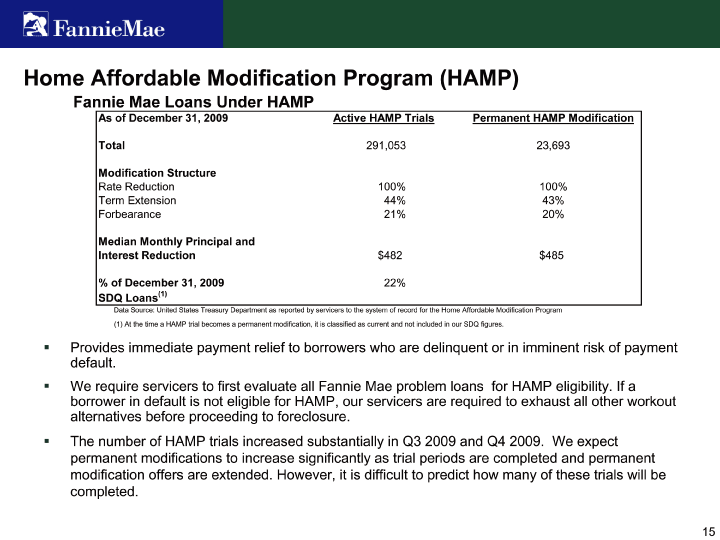
| Home Affordable Modification Program (HAMP) |
| Fannie Mae Loans Under HAMP |
| As of December 31, 2009 Active HAMP Trials Permanent HAMP Modification |
| Total 291,053 23,693 |
| Modification Structure |
| Rate Reduction 100% 100% |
| Term Extension 44% 43% |
| Forbearance 21% 20% |
| Median Monthly Principal and |
| Interest Reduction $482 $485 |
| % of December 31, 2009 22% |
| SDQ Loans(1) |
| Data Source: United States Treasury Department as reported by servicers to the system of record for the Home Affordable Modification Program (1) At the time a HAMP trial becomes a permanent modification, it is classified as current and not included in our SDQ figures. |
| Provides immediate payment relief to borrowers who are delinquent or in imminent risk of payment default. |
| We require servicers to first evaluate all Fannie Mae problem loans for HAMP eligibility. If a borrower in default is not eligible for HAMP, our servicers are required to exhaust all other workout alternatives before proceeding to foreclosure. |
| The number of HAMP trials increased substantially in Q3 2009 and Q4 2009. We expect permanent modifications to increase significantly as trial periods are completed and permanent modification offers are extended. However, it is difficult to predict how many of these trials will be completed. |
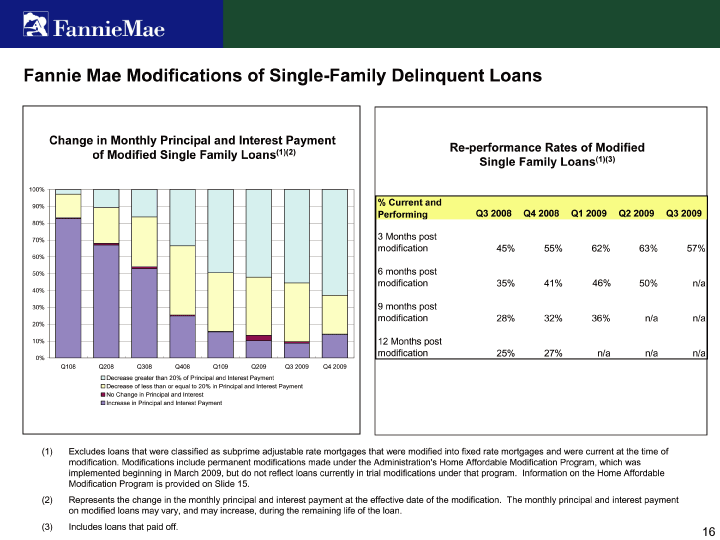
| Fannie Mae Modifications of Single-Family Delinquent Loans |
| (1) Excludes loans that were classified as subprime adjustable rate mortgages that were modified into fixed rate mortgages and were current at the time of modification. Modifications include permanent modifications made under the Administration’s Home Affordable Modification Program, which was implemented beginning in March 2009, but do not reflect loans currently in trial modifications under that program. Information on the Home Affordable |
| Modification Program is provided on Slide 15. |
| (2) Represents the change in the monthly principal and interest payment at the effective date of the modification. The monthly principal and interest payment on modified loans may vary, and may increase, during the remaining life of the loan. |
| (3) Includes loans that paid off. |
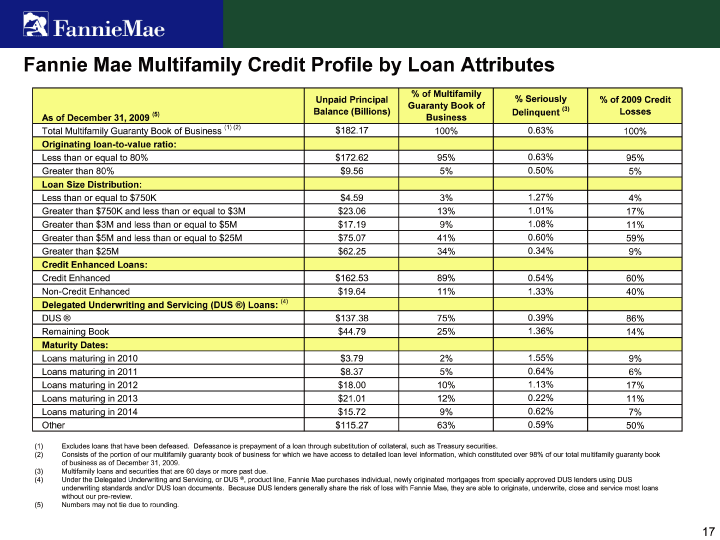
| Fannie Mae Multifamily Credit Profile by Loan Attributes |
| % of Multifamily |
| Unpaid Principal % Seriously % of 2009 Credit |
| Guaranty Book of |
| Balance (Billions) Delinquent (3) Losses |
| As of December 31, 2009 (5) Business |
| Total Multifamily Guaranty Book of Business (1) (2) $182.17 100% 0.63% 100% |
| Originating loan-to-value ratio: |
| Less than or equal to 80% $172.62 95% 0.63% 95% |
| Greater than 80% $9.56 5% 0.50% 5% |
| Loan Size Distribution: |
| Less than or equal to $750K $4.59 3% 1.27% 4% |
| Greater than $750K and less than or equal to $3M $23.06 13% 1.01% 17% |
| Greater than $3M and less than or equal to $17.19 9% 1.08% 11% $5M |
| Greater than $5M and less than or equal to $25M $75.07 41% 0.60% 59% |
| Greater than $25M $62.25 34% 0.34% 9% |
| Credit Enhanced Loans: |
| Credit Enhanced $162.53 89% 0.54% 60% |
| Non-Credit Enhanced $19.64 11% 1.33% 40% |
| Delegated Underwriting and Servicing (DUS ®) Loans: (4) |
| DUS ® $137.38 75% 0.39% 86% |
| Remaining Book $44.79 25% 1.36% 14% |
| Maturity Dates: |
| Loans maturing in 2010 $3.79 2% 1.55% 9% |
| Loans maturing in 2011 $8.37 5% 0.64% 6% |
| Loans maturing in 2012 $18.00 10% 1.13% 17% |
| Loans maturing in 2013 $21.01 12% 0.22% 11% |
| Loans maturing in 2014 $15.72 9% 0.62% 7% |
| Other $115.27 63% 0.59% 50% |
| (1) Excludes loans that have been defeased. Defeasance is prepayment of a loan through substitution of collateral, such as Treasury securities. |
| (2) Consists of the portion of our multifamily guaranty book of business for which we have access to detailed loan level information, which constituted over 98% of our total multifamily guaranty book of business as of December 31, 2009. |
| (3) Multifamily loans and securities that are 60 days or more past due. |
| (4) Under the Delegated Underwriting and Servicing, or DUS ®, product line, Fannie Mae purchases individual, newly originated mortgages from specially approved DUS lenders using DUS underwriting standards and/or DUS loan documents. Because DUS lenders generally share the risk of loss with Fannie Mae, they are able to originate, underwrite, close and service most loans without our pre-review. |
| (5) Numbers may not tie due to rounding. |
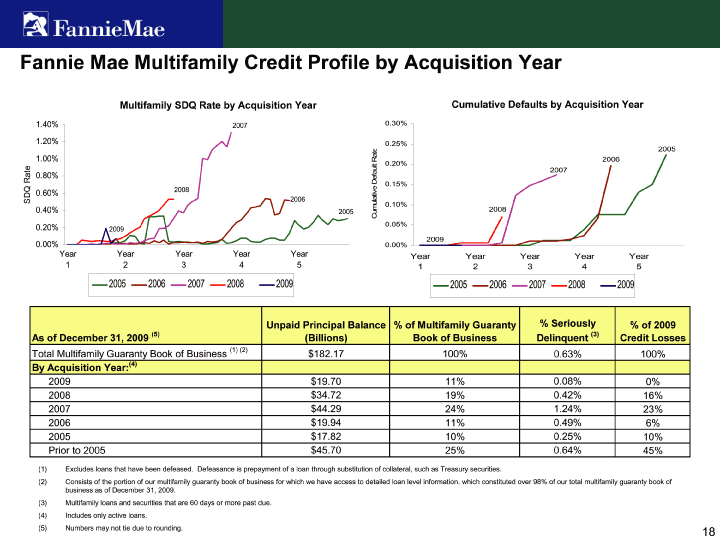
| Fannie Mae Multifamily Credit Profile by Acquisition Year |
| (1) Excludes loans that have been defeased. Defeasance is prepayment of a loan through substitution of collateral, such as Treasury securities. |
| (2) Consists of the portion of our multifamily guaranty book of business for which we have access to detailed loan level information, which constituted over 98% of our total multifamily guaranty book of business as of December 31, 2009. |
| (3) Multifamily loans and securities that are 60 days or more past due. (4) Includes only active loans. |
| (5) Numbers may not tie due to rounding. |
